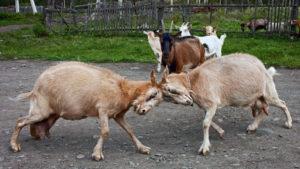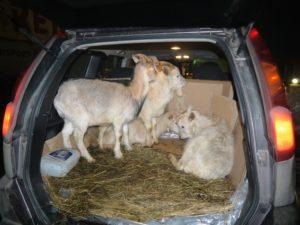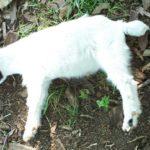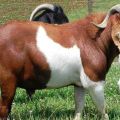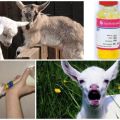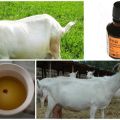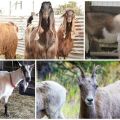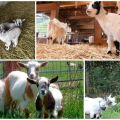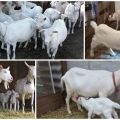Description and characteristics of faint goats, rules of keeping
Nature sometimes surprises a person much more than fictional events or fantastic assumptions. She is able to create bizarre living creatures, original unique colors or methods of protection from danger, distinguished by special extravagance. An example of such natural ingenuity can be found in the unusual properties of the swoon goat, a special breed bred in the United States.
Goat history and human interaction
This breed is called Myotonic or Tennessee, and has several other names, including swoon goats. This is due to the fact that from the outside it often seems that the goat suddenly fainted at the slightest threat or fright.
The first documentary evidence of the existence of the breed appeared in 1880. Tinsley, a Tennessee farmer, sold the first known representatives of this variety to a buyer. The significant period of existence of swooning goats did not affect their numbers. The penchant for strange behavior did not contribute to their popularity and active breeding.
Despite the fact that fainted animals can be difficult to keep, because they constantly fall into a daze, often at the most inopportune moment, they were bred and kept, especially in small farms. In fact, goats were sacrificed. They were included in the herd, for example, of the same valuable breeds, sheep or other farm animals. If the herd was attacked by a predator, the swooning goat was numb and fell to the wolf or coyote as prey, and the rest of the herd remained unharmed.
Later they began to be used for entertainment. Their sudden muscle spasms and falls amused toddlers and adults who came to America's popular country fairs.
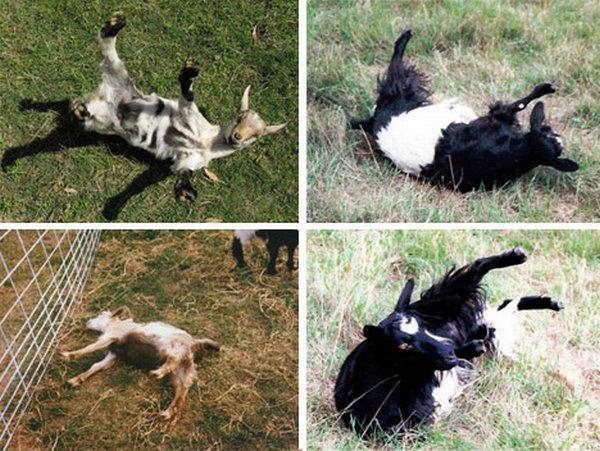
Causes of the phenomenon
Fainting is a rare genetic disorder called myotonia congenital. It manifests itself as tonic muscle spasms, that is, what outwardly looks like a loss of consciousness, in fact, just a temporary paralysis, literally knocking you off your feet. It lasts no more than 10-15 seconds, while the animal remains conscious.
A sudden fall can be caused not only by fear, but also by any strong emotion. This can be receiving food or a desired treat, the approach of an individual of the opposite sex, or simply the joyful excitement of a game or a sunny day.
The fall of an animal can look comical, but it is quite capable of injury or death if it suddenly falls in the wrong place.However, many generations have developed a kind of immunity against injury, so in most cases, their fainting ends for them without noticeable consequences.

Description and characteristics of the breed
Faint goats are smaller in stature than representatives of other breeds, but much wider, since they are able to gain more body weight due to reduced mobility and activity. Their parameters:
- Height at withers: 43-64 centimeters.
- Weight: 27-79 kilograms. Adult unconscious goats can gain up to 100 kilograms. The average body weight of myotonic goats is 35-40% more than that of congeners.
- Bulging large eyes.
- The coat can be of different lengths. There are "wooden goats" with short or long hair, as well as those that can be attributed to the group of cashmere or angora breeds. It all depends on what varieties the ancestors of the "nervous" creatures were crossed with.
- Black and white color is common, but it is not a fundamental characteristic of the breed because "stiff-footed goats" are found in all color variations.
In addition to a genetic anomaly and some minor features of appearance, this breed is no different from its relatives.
Pros and cons
The advantages of swoon goats are that they can be used as a source of dietary meat and also provide decent quality wool. Sometimes it approaches the level of cashmere fiber, and some animals can produce soft and fluffy down, like angora goats.
Also, these funny creatures can be used as a live attraction, that is, they serve as decorative representatives in zoos or circuses.
Farmers following ancient traditions continue to keep and breed this breed as a kind of protection. In a herd, such a goat can serve as an indicator of impending danger.
Keeping swoon goats
The common goat is a lively and energetic animal. One has only to weaken supervision, as she already chews flowers in the front garden or climbs onto the roof of a barn or even a house. But the situation is different with swoon goats. Because of the disease, they are not so playful, so they do not jump over fences and do not climb fences. In order to arrange life for a small herd, it is enough to build a warm barn for them with safe stalls lined with straw, as well as equip a grass area for walking in the fresh air.

Taking into account the peculiarities of the breed, it is necessary to remove foreign objects on grazing so that the animals cannot hit in case of a sudden fall.
What to feed
Like the rest of the species, swooning goats are picky about food. In the summer they need a lot of fresh food, mainly grass, in winter they need hay, preferably from young plants - forest or meadow. Also, animals are fed with "brooms" - bunches of branches with leaves cut from willow, poplar or birch. If necessary, the fainting goat will eat anything - both straw from the litter, and completely dry, seemingly inedible branches.
The animals are given juicy food: boiled potatoes, fodder beets, carrots, cabbage, and it is not necessary to give whole, high-quality root vegetables and leafy vegetables. Faint goats are happy to eat tops, cuttings and leftovers from the garden, the main thing is to ensure their cleanliness and sufficient quantity.
Also, animals need to ensure the supply of minerals. To do this, they are given chalk, neutralizing the acidity of green products, as well as providing constant access to lick salt and clean drinking water.

In cold weather, the amount of concentrated feed is increased, remembering that too much feed becomes the cause of the development of urolithiasis.Faint goats are very fond of grain, this is a delicacy for them, but you cannot build a diet on it. Food should be varied and complete, balanced, rich in vitamins and minerals.
Breeding rules
The gene that causes myotonia in goats is recessive. This means that when crossed in the first generation, such a trait will not appear, since it will be suppressed by the dominant genes. A quarter of the resulting offspring in the second generation will have a recessive gene. In the case of swooning goats, this means that the second generation of offspring runs the risk of getting a tendency to myotonia in 25% of the total number of born kids.
Disease prevention
In order for the goats to be healthy, it is necessary to properly maintain and feed them, as well as timely identify signs of illness, isolate the sick animal and call a veterinarian.
Goats are susceptible to digestive problems associated with eating moist green food or drinking immediately after such food. Therefore, they are driven out to the pasture after the dew has melted, or the grass dries up after rain, fog. You can drink one hour after feeding a juicy plant food.
Due to improper maintenance, goats can develop skin problems or hoof lesions. Many difficulties can be avoided with hygiene measures, frequent cleaning of the barn, and using bedding. It is more difficult to prevent parasitic and infectious diseases, but vaccinations, cleanliness and quick removal of a sick individual from the herd will help here.
Faint goats have a genetic problem that cannot be cured with medication or other methods. Therefore, when breeding them, it is advisable to select the strongest and healthiest producers. Then the offspring will not be weakened, and the gene that gives the goats originality will be passed on to the otherwise healthy offspring.
